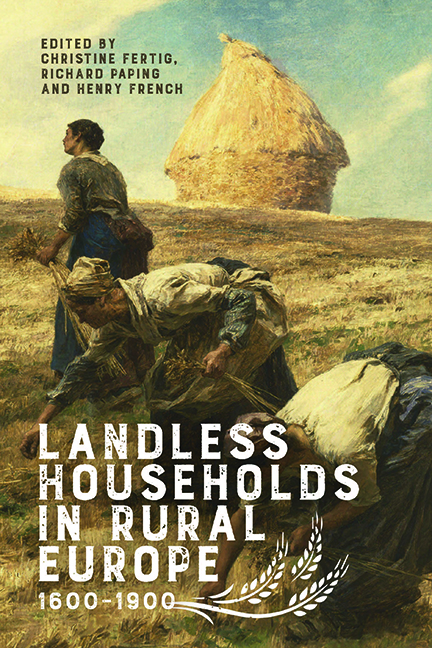Book contents
- Frontmatter
- Contents
- List of Illustrations
- Notes on Contributors
- Preface
- Introduction
- 1 The Treballadors of Girona: Evidence of the Emergence of Wage Labour in Early Modern Catalonia in the Sixteenth and Seventeenth Centuries
- 2 The Squatter Economy of the English Countryside: Building New Landless Communities in England, c. 1600–1900
- 3 The Rise of Landless Households in the Dutch Countryside, c. 1600–1900
- 4 ‘Gaining Ground’ in Flanders after the 1840s: Access to Land and the Coping Mechanisms of Landless and Semi-Landless Households, c. 1850–1900
- 5 Strategies of Survival, Landlessness and Forest Settlement in Flanders: The Forest of Houthulst in a Changing Landscape of Survival (c. 1500–1900)
- 6 Landless and Pauper Households in England, c. 1760–1835: A Comparison of Two Southern English Rural Communities
- 7 Landless Rural Households in France, 1852–1910
- 8 Survival in a Hostile Agrarian Regime: Landless and Semi-Landless Households in Seventeenth-Century Sweden and Finland
- 9 Farming Craftsmen? Access to Land and the Socio-Economic Position of Rural Artisans in Early Modern Finland
- 10 Landlessness and Marriage Restrictions: Tyrol and Vorarlberg in the Eighteenth and Nineteenth Centuries
- 11 Cottages, Barns and Bake Houses: Landless Rural Households in North-Western Germany in the Eighteenth Century
- Bibliography
- Index
- Boydell Studies in Rural History
5 - Strategies of Survival, Landlessness and Forest Settlement in Flanders: The Forest of Houthulst in a Changing Landscape of Survival (c. 1500–1900)
Published online by Cambridge University Press: 08 October 2022
- Frontmatter
- Contents
- List of Illustrations
- Notes on Contributors
- Preface
- Introduction
- 1 The Treballadors of Girona: Evidence of the Emergence of Wage Labour in Early Modern Catalonia in the Sixteenth and Seventeenth Centuries
- 2 The Squatter Economy of the English Countryside: Building New Landless Communities in England, c. 1600–1900
- 3 The Rise of Landless Households in the Dutch Countryside, c. 1600–1900
- 4 ‘Gaining Ground’ in Flanders after the 1840s: Access to Land and the Coping Mechanisms of Landless and Semi-Landless Households, c. 1850–1900
- 5 Strategies of Survival, Landlessness and Forest Settlement in Flanders: The Forest of Houthulst in a Changing Landscape of Survival (c. 1500–1900)
- 6 Landless and Pauper Households in England, c. 1760–1835: A Comparison of Two Southern English Rural Communities
- 7 Landless Rural Households in France, 1852–1910
- 8 Survival in a Hostile Agrarian Regime: Landless and Semi-Landless Households in Seventeenth-Century Sweden and Finland
- 9 Farming Craftsmen? Access to Land and the Socio-Economic Position of Rural Artisans in Early Modern Finland
- 10 Landlessness and Marriage Restrictions: Tyrol and Vorarlberg in the Eighteenth and Nineteenth Centuries
- 11 Cottages, Barns and Bake Houses: Landless Rural Households in North-Western Germany in the Eighteenth Century
- Bibliography
- Index
- Boydell Studies in Rural History
Summary
In this chapter, I will focus on a specific group of landless people, the so-called forest settlers (boskanters in Dutch). In general, research in rural history has a strong bias towards the landowning part of the rural population. Regarding landless households, considerable research has been done on the income strategies of households involved in rural proto-industries. Landless people making a living from agricultural wage work and rural craftsmen have gained much less attention. In recent years, those groups (who generally formed the poorest part of rural society) have partly been studied by historians focusing on migration, settlement and poor relief – or more broadly welfare entitlements. Some interesting research has also been done on rural servants and the place of service within the lifecycle of rural populations. I want to add to this inspiring line of research with a study on the survival strategies of settled landless households around the Forest of Houthulst during the period c. 1500–1900. I will specifically focus on the origin of these landless groups and how forest enclosure impacted upon their socio-economic position. In doing so, I will build on a reappraisal of the legacy of E. P. Thompson in the work of Nicola Whyte and Andy Wood and their explorations in writing a landscape history from below. Rather than looking merely at how landless families shaped the landscape, I focus on how these groups experienced and strategically used an unclear property situation to make their livelihood in this specific region.
Although the Forest of Houthulst and its boskanters have gained some attention in the literature, from the Flemish writer Victor Huys (1829–1905) to the famous French-Belgian author Marguerite Yourcenar (1903–87), the subject has been largely neglected by twentieth-century historians. However, during the nineteenth century, renowned historians such as Jules de Saint-Genois (1813–67) showed great interest in the boskanters, linking these forest settlers to the ‘primitive inhabitants’ of Flanders. All these writers had experienced the Forest of Houthulst in its ancient form, even Yourcenar who spent parts of her childhood in a North French country house owned by her family, in a hilly region some 30 kilometres away from the forest.
- Type
- Chapter
- Information
- Landless Households in Rural Europe, 1600-1900 , pp. 117 - 138Publisher: Boydell & BrewerPrint publication year: 2022



